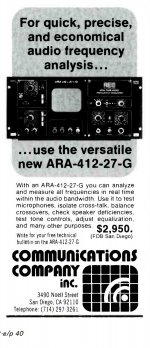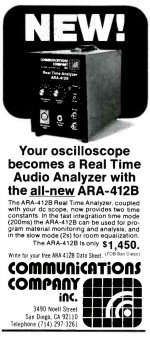I've got an opportunity to pick one of these up, cheap. There's precious little about it on the web - basically one ad from a 1978 issue of Recording Engineering and Producing (?) magazine.
Looks like an RTA built around a small CRT oscilloscope; they also made a version that would plug into your own scope, for $1500 less. Appears to be about 6RU tall.
Does anyone know anything about this device, or this company? They've still got a web presence as part of Audio Intl., but there's nothing about this or anything like it. It apparently still works, so I figure if nothing else it can be an interesting conversation piece.
Looks like an RTA built around a small CRT oscilloscope; they also made a version that would plug into your own scope, for $1500 less. Appears to be about 6RU tall.
Does anyone know anything about this device, or this company? They've still got a web presence as part of Audio Intl., but there's nothing about this or anything like it. It apparently still works, so I figure if nothing else it can be an interesting conversation piece.
Attachments
It depends how cheap ?
Keep in mind an HP3580A isn't pricey or a HP3562A both audio plus ranges --there are others .
Dont buy from companies supplying "refurbished" etc as not unexpectedly there is a big price increase.
Keep in mind an HP3580A isn't pricey or a HP3562A both audio plus ranges --there are others .
Dont buy from companies supplying "refurbished" etc as not unexpectedly there is a big price increase.
The CRT may be weak, which means big money in repair.
Solid state LCD scopes are about $400 and up, try those, you might get one off your local on line flea market, lots of businesses going out of business.
Solid state LCD scopes are about $400 and up, try those, you might get one off your local on line flea market, lots of businesses going out of business.
The dude's asking $100, but I can probably get it for. $80. So, a tenth of the cost of an HP3580A.
I guess the question is, since it was originally intended for live sound room analysis, is it high enough resolution for evaluating distortion harmonics? I recall that other RTAs from that era were basically looking at 1/3 octave bands.
I guess the question is, since it was originally intended for live sound room analysis, is it high enough resolution for evaluating distortion harmonics? I recall that other RTAs from that era were basically looking at 1/3 octave bands.
I think its like a vintage all analog RTA similar to the rare HP 8050a. Analog filters scanned and displayed. pros- instantaneous response. Cons- old, large, limited. You can do better today with apps on your phone.
I think its like a vintage all analog RTA similar to the rare HP 8050a. Analog filters scanned and displayed. pros- instantaneous response. Cons- old, large, limited. You can do better today with apps on your phone.
The more I think about it, the more I tend to think that the $80 would be much better spent going toward one of pmillett's sound card interface boards and associated components. It's just so hard, because this pushes so many of my buttons - vintage, obscure, cool looking, and (relatively) cheap! But "useful" almost always wins, and pmillett's sound card interface seems waaaaay more useful.
- Home
- Design & Build
- Equipment & Tools
- Audio Engineering Components ARA-412-27-G?

